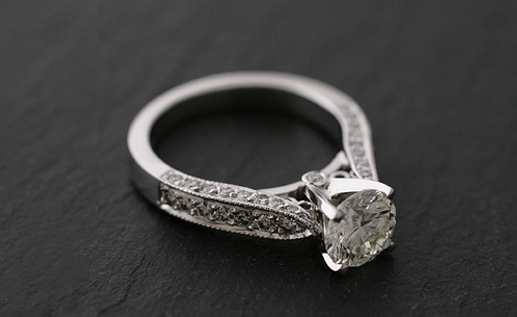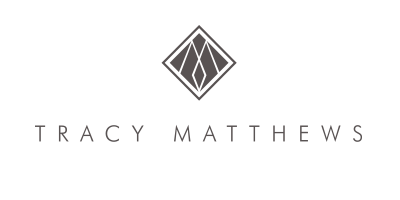How to Select the Perfect Diamond

Selecting the perfect diamond for an engagement ring can be a stressful endeavor! Are you confused about where to start?
You might have heard of “The 4 C’s” in passing. You may even know the actual C’s – Color, Clarity, Cut, and Carat weight. But when it comes down to it, many people don’t know how these attributes are measured, and how they can help you pick a diamond that suits your specific wants and needs.
Today, I’m going to go through the the 4 C’s, and give you an overall idea of how to compare diamonds. But more importantly, I’m going to give you some advice on deciding which of the 4 C’s is most important to you!
So let’s start from the top!
Color
A diamond’s color is graded from D (perfectly colorless) to Z (yellow/brown tinted). Truly colorless D graded diamonds are actually very rare, and most people choose diamonds somewhere along this scale. I’ve added a chart below from International Gemological Institute, so you can get a feel for where along the scale is right for you.
(source: http://igionline.com/igi_4Cs.htm)
Of course, every diamond is different. In my opinion, color is the first thing most people notice to the naked eye. However, there are 4 C’s for a reason, not just one, so let’s take a look at the other factors to consider.
Clarity
There is a grading system for clarity as well, ranging anywhere from “Flawless” and “Internally Flawless” to “I1”, “12,” and “13.” Check out the visual below from GIA’s 4 C’s pamphlet, which you can download here.
It’s important to note that many gem experts use these imperfections to sort out true diamonds from synthesized ones. It’s also super important to note that most of these blemishes, or “inclusions” are rarely noticeable to the naked eye! Most people buy somewhere around VVS (which stands for Very Very Slightly Included) to SI (Slightly Included). These are usually “eye clean” or perfect to the naked eye, as “Flawless” diamonds are very expensive. In my opinion, the other C’s are more important, but it’s all up to your preferences!
Cut
Oh, the cut! This is where I personally get the most nitpicky. Why? Because a diamond’s cut really determines how much a diamond sparkles, and who doesn’t love sparkle?
The GIA color grade scale ranges from “Excellent” to “Poor,” but GIA actually measures quite a few things. They look at “Brightness,” or how clearly the diamond reflects white light, as well as “Fire” or “flares of color” and “Scintillation” or “the pattern of light and dark areas” when a diamond sparkles.
Essentially, if a cut is too shallow or too deep, less light will leave from what is know as the “table” – the flat top of the diamond. Some people may choose to get a shallower cut, providing more “table” space for their dollar in some cases. While this might be a good idea for you, I’d highly suggest checking out different diamond cuts in person.
Beyond the actual depth and “sparkle” measurements, you’ll also want to consider the number of facets the gem has. You should also triple check that your gem is symmetrical. Lastly, if you’re deciding between two gems, the best way to differentiate is to simple look at them side by side.
Seeing the difference in “sparkle” is really something I’d suggest doing in person, and there just isn’t a way to truly put it into words no matter how are gemologist try!
(source: http://bit.ly/1itDGeM, http://bit.ly/1nBOqUk)
Carat Weight
In a perfect world, these would be the exact measurements
Now, get prepared to be floored: Carat weight simply measures the weight of the diamond, and does not necessarily accurately measure a diamond’s size. Diamonds in specific carat ranges have similar diameters, but this is where you can see how the connection with the previous “C” the cut, comes into play.
So often these days we hear women pining for a bigger sized diamond over anything else! The truth is, a diamond’s carat weight is a lot more complicated. Remember how I was talking about shallower diamonds? A shallow diamond with the same carat weight as a deeper diamond will have more surface area, and therefore appear larger from the top. Charts like the one above are usually based on the average depth, not a very shallow or deep cut. This is crucial to keep in mind when selecting a diamond.
When you’re selecting your diamond and deciding between varying carats, definitely factor in the diameter of the “table” top of the diamond and cut.
(Source: bit.ly/1rNFT4O, bit.ly/1nBOqUk)
Certification
This is a 5th C you should always check out. Before actually buying the diamond of your choice, you should be presented with it’s certification or grading report. These reports come from a gemology lab (usually GIA, AGSL or EGL in Europe) and includes measurements of the 4 C’s in the most unbiased way possible. Always take an extra look at this before officially handing over your cash, in the off chance you notice something not quite right and would like to change gems.
So, which diamond is for you?
Most ladies would sacrifice a perfectly colored and cut diamond for a higher carat weight. What about you?
I’d really like to hear your stories about how you have decided on a diamond in the past. In the comments below, tell me which of the 4 C’s is most important to you.

Hi Tracy Matthews,
Nice Post !!
Diamonds are girls best friend.Selecting a diamond ring is very fruitful task . A great advise and expertise can help you a lot. Thanks for sharing the post .